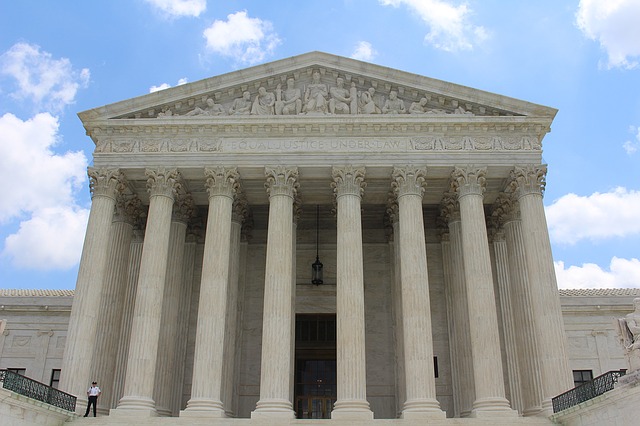
By Kristin Hoffman, Staff Writer
The Supreme Court began its October 2016 term last Monday. The bench, however, had a vacant seat after the death of Justice Antonin Scalia in February. His seat remains empty because the Senate has yet to vote on President Barack Obama’s nomination, Merrick Garland.
The Court will proceed with this term with eight justices. This begs the question of whether there will be 4-4 splits in the absence of a conservative majority. The liberal wing of the Supreme Court — consisting of Justices Ruth Bader Ginsburg, Sonia Sotomayor, Stephen Breyer, and Elena Kagan — could likely come into conflict ideologically with the conservative wing, consisting of Chief Justice John Roberts and Justices Clarence Thomas, Samuel Alito, and Anthony Kennedy.
A 4-4 split of the Supreme Court would result in affirming the decision of the lower court, which is what happened in United States v. Texas in June.[1] The tie resulted in an affirmance of the lower court’s decision and upheld a nationwide injunction of the Obama administration’s shield of unauthorized immigrants from deportation.[2] Scalia’s presence would have likely resulted in a 5-4 decision and the same result. If Obama’s nomination had been confirmed, however, it would have likely gone the other way in a win for the Obama administration.
This term, it seems as if the Supreme Court has decided to avoid cases in which the ideological split would cause a split court. The Court avoided scheduling oral arguments in a case it agreed to hear before Scalia’s passing; the case concerns whether the State of Missouri can exclude a Lutheran church daycare center from its state pram, which grants awards for the resurfacing of playgrounds, on the basis of the constitutional hallmark of separation of church and state.[3]
Instead, the Court will hear several intellectual property cases this term. One case concerns whether an Oregon-based rock band can forcibly trademark its name “The Slants,” despite its history as an Asian racial slur and the disparagement provision of the Lanham Act.[4] Another intellectual property case will charge the Court with deciding a major dispute between electronic giants Samsung Electronics and Apple Inc.: Whether, when infringed upon, a design patent applicable to only a component part of a product limits the award of profits only to the profits attributed to that component part?[5]
The Court will also hear a case concerning discrimination and predatory lending. It will decide whether the city of Miami can sue Bank of America Corp.[6] and Wells Fargo & Co.[7] as an “aggrieved person” under the Fair Housing Act over their lending practices. The Fourth Amendment right to be free from unreasonable seizure will also again come before the Court: A case will determine whether the rights granted under the amendment go beyond legal process and allow for a malicious prosecution claim to be based upon that right.[8]
This term will undoubtedly be interesting. This is the first time since Abraham Lincoln’s re-election in 1864 that there will be a vacancy on the bench on a presidential Election Day.[9] The vacant seat has been a topic of discussion for the presidential candidates and commentators on both sides. It does not seem as if the Senate plans to consider Obama’s nomination to the Court before the presidential election in November. The result of the latter will have a substantial effect on the direction the Supreme Court will head after the death of conservative giant Antonin Scalia.
Sources
[1] United States v. Texas, No. 15-577, www.scotusblog.com/case-files/cases/united-states-v-texas/.
[2] Adam Liptak, Larry Buchanan and Alicia Parlapiano, How a Vacancy on the Supreme court Affected Cases in the 2015-2016 Term, New York Times, http://www.nytimes.com/interactive/2016/02/14/us/politics/how-scalias-death-could-affect-major-supreme-court-cases-in-the-2016-term.html.
[3] Trinity Lutheran Church of Columbia v. Pauley, No. 15-577, www.scotusblog.com/case-files/terms/ot2016.
[4] Lee v. Tam, No. 15-1293, www.scotusblog.com/case-files/terms/ot2016.
[5] Samsung Electronics Co. v. Apple, No. 15-777 (Arg: 10.11.2016), www.scotusblog.com/case-files/terms/ot2016.
[6] Bank of America Corp v. City of Miami, No. 15-1111 (Arg: 11.8.2016), www.scotusblog.com/case-files/terms/ot2016.
[7] Wells Fargo & Co. v. City of Miami, No. 14-1055 (Arg: 11.8.2016), www.scotusblog.com/case-files/terms/ot2016.
[8] Manuel v. City of Joliet, No. 14-9496 (Arg: 5.2016), www.scotusblog.com/case-files/terms/ot2016.
[9] Lawrence Hurley, Supreme Court Returns to Work with Glaring Vacancy, Reuters, Sept. 30, 2016, http://www.reuters.com/article/us-usa-court-term-idUSKCN1201JP.
